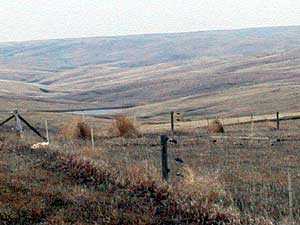|
Audio
Photos
Your Voice
|
Spring storms critical for billion dollar drought
March 18, 2003
 |
| Normally the pasture on the Jorgensen ranch is more than ankle high in March. But this year you can see small birds and mice scurry through the dirt. (MPR Photo/Cara Hetland) |
Ideal, S.D. — Martin Jorgensen has seen it drier, but not for a long time.
"Right in this immediate area, I would have to say the spring of 1976 looked more dismal than it does right now." says Jorgensen. "We can sustain ourselves for the next couple of months."
 | |||
The 78 year-old rancher lives near Ideal, South Dakota. He's proud of the changes his sons have made to the operation. They adopted no-till farming on their 9,500 acres of crop land more than a decade ago. That means they leave corn stock stubble after the harvest to prevent snow from blowing away or rain from evaporating.
Jorgensen pulls up a piece of stock and sticky wet black dirt remains.
"See that ground is very wet?" he says. "We could probably probe maybe four or five feet of moisture here. Because none of it has never left through evaporation or anything else like crop growing. It's still here waiting for the corn crop."
Jorgensen is more concerned about his 6,500 acres of pasture land. The land of rolling hills is bare. There are clumps of green yucka plants, they're desert plants. But the cows won't touch those. Normally the grass cover is more than ankle high. But on this windy spring day, you can see small birds and mice scurry through the dry grass.
 | |||
Ranchers do everything they can to avoid over-grazing but Jorgensen says last summer, he was forced to. They had to feed the livestock something.
"We just move those cattle about every five days. That way it gives the good grasses a chance to rejuvinate," he says.
Jorgensen says spring rain will determine if the pasture can sustain his cattle this year. Normally this region of central South Dakota receives 20 inches of rain a year. Most of it comes in the spring and fall.
"Up to the end of July we only had 4.6 inches of moisture, including all of the snow - 4.6 inches," Jorgensen says. "That was essentially our growing season. We were kind of left out."
There were several weeks of 100 degree temperatures which further dried an already thirsty ground.
Climatologists are watching the upper midwest very closely. Drought specialist Douglas LeComte sees a wetter spring for western South Dakota, but then, a drier year. He expects the drought forecast to widen.
"It was a very dry winter," LeComte says. "The second driest winter if you define winter as December to February, the second driest winter in 108 years in Minnesota, Iowa and Wisconsin and the driest ever in Michigan and that's because of the storm track."
For the last couple of years, rain and snow systems have dipped to the south or east of South Dakota. Many ranchers have sent livestock to farms in Nebraska and Minnesota to feed over the winter. Some are even selling off their herd. There are 250,000 fewer cattle in South Dakota than a year ago.
Economists at South Dakota State University say the drought has had $1.4 billion impact on the state's ecnomy.
Many people are watching the track of the latest storm system. It could make or break many operations in western South Dakota. Rancher Brian Jorgensen says it best.
"It's funny what a little rain will do to a farmer's outlook on things," he says.
|
News Headlines
|
Related Subjects
|
